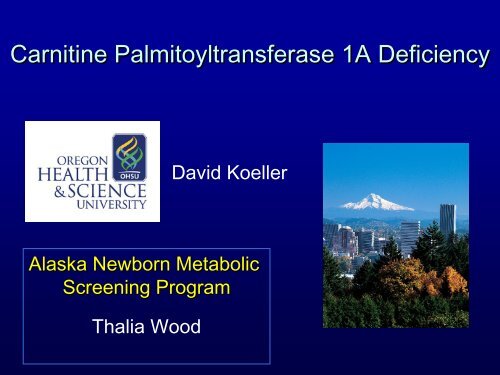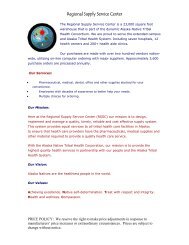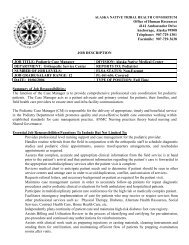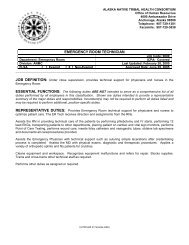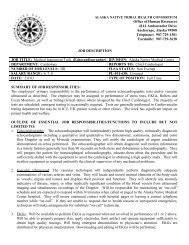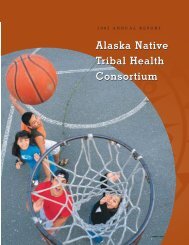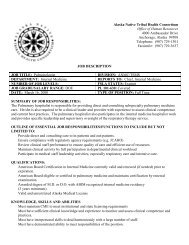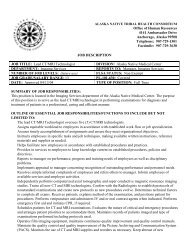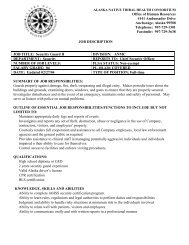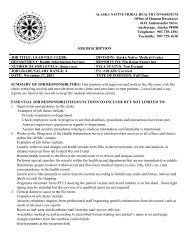CPT1 Deficiency Update - ANTHC
CPT1 Deficiency Update - ANTHC
CPT1 Deficiency Update - ANTHC
You also want an ePaper? Increase the reach of your titles
YUMPU automatically turns print PDFs into web optimized ePapers that Google loves.
Carnitine Palmitoyltransferase 1A <strong>Deficiency</strong><br />
David Koeller<br />
Alaska Newborn Metabolic<br />
Screening Program<br />
Thalia Wood
Goals<br />
• Carnitine Palmitoyltransferase 1 (<strong>CPT1</strong>)<br />
• <strong>CPT1</strong>A deficiency<br />
• Newborn Screening for <strong>CPT1</strong>A <strong>Deficiency</strong><br />
• Public Health Concerns
<strong>CPT1</strong> is required for the import of<br />
long chain fatty acids into the<br />
mitochondrial matrix for oxidation
Inner mitochondrial<br />
membrane<br />
Outer mitochondrial<br />
membrane
In the presence of an adequate glucose<br />
supply fatty acid oxidation is repressed<br />
• Insulin inhibits hormone sensitive lipase in adipose<br />
tissue, blocking release of free fatty acids into the<br />
blood<br />
• Mitochondrial import of long chain fatty acids is<br />
blocked via inhibition of <strong>CPT1</strong> by malonyl-CoA,<br />
which is generated from acetyl-CoA derived from<br />
glucose oxidation
Regulation of <strong>CPT1</strong> activity<br />
Glucose<br />
Fatty Acid Synthase
Regulation of <strong>CPT1</strong> activity
There are 3 <strong>CPT1</strong> Isoforms<br />
<strong>CPT1</strong>A<br />
<strong>CPT1</strong>B<br />
<strong>CPT1</strong>C<br />
Liver, kidney, leucocytes, fibroblasts, brain<br />
Muscle, white adipose tissue<br />
Brain, testes<br />
60% homology between isoforms of <strong>CPT1</strong>A<br />
Only <strong>CPT1</strong>A deficiency identified in humans
Goals<br />
• <strong>CPT1</strong>A<br />
• <strong>CPT1</strong>A deficiency<br />
• Newborn Screening for <strong>CPT1</strong>A <strong>Deficiency</strong><br />
• Implications for Public Health
<strong>CPT1</strong>A <strong>Deficiency</strong><br />
• Affects ability to use long chain fatty acids for energy<br />
• Symptoms precipitated by prolonged fasting, and<br />
exacerbated by metabolic stress<br />
– Fever<br />
– Infection<br />
– Dehydration<br />
• Symptoms are similar to other fatty acid oxidation disorders<br />
– Hypoketotic hypoglycemia<br />
• Symptoms may be present before glucose drops<br />
– Hepatic encephalopathy<br />
– Acute and/or persistent seizures secondary to recurrent<br />
hypoglycemia<br />
– Sudden unexplained death: SIDS<br />
• HELLP Syndrome (hypertension, elevated liver enzymes, low platelets)
<strong>CPT1</strong>A <strong>Deficiency</strong>: Treatment<br />
• Avoid fasting<br />
– Feeds infants every 3-4 hours during first 3 months of life<br />
and then allow fasting equal to age in months up to ten<br />
months (10 hours).<br />
– From 12-24 months should go no longer than 10 hours<br />
– After 24 months can go for 12 hours and probably longer<br />
• Fasting guidelines apply only in times of good<br />
health; illness and surgical stress decrease the<br />
length of time fasting can be tolerated<br />
• Avoidance of long chain fats is often recommended<br />
but unproven - and likely impractical in the Alaska<br />
Native population
Goals<br />
• <strong>CPT1</strong>A<br />
• <strong>CPT1</strong>A deficiency<br />
• Newborn Screening for <strong>CPT1</strong>A <strong>Deficiency</strong><br />
• Public Health Concerns
Newborn Screening for <strong>CPT1</strong>A <strong>Deficiency</strong><br />
• <strong>CPT1</strong>A deficiency is identified by a high ratio of free<br />
carnitine (C0) to the sum of palmitoylcarnitine (C16) plus<br />
stearoylcarnitine (C18)<br />
• The C0 / (C16+C18) is elevated as a direct result of a<br />
decreased ability to make acylcarnitines<br />
• The ability to identify infants with <strong>CPT1</strong>A deficiency resulted<br />
from the switch to expanded newborn screening using<br />
tandem mass spectrometry (MS/MS) in the Fall of 2003
Newborn Screening for <strong>CPT1</strong>A <strong>Deficiency</strong><br />
• Since October of 2003 there have been 129 infants<br />
identified with <strong>CPT1</strong>A deficiency in Alaska (8/15/08)<br />
• All have been homozygous for the C1436T DNA<br />
variant that results in the substitution of proline 479<br />
with leucine ( P479L)<br />
• All affected infants have been born to Mothers that<br />
identified themselves as Alaska Native on their<br />
newborn screening card
Goals<br />
• <strong>CPT1</strong>A<br />
• <strong>CPT1</strong>A deficiency<br />
• Newborn Screening for <strong>CPT1</strong>A <strong>Deficiency</strong><br />
• Public Health Concerns
The Big Questions:<br />
• What is the clinical impact of the P479L<br />
sequence variant ?<br />
• What is the true incidence of <strong>CPT1</strong>A<br />
deficiency in Alaska<br />
• Do we need to identify and treat affected<br />
infants ?
The Big Questions:<br />
• What is the clinical impact of the P479L<br />
sequence variant ?<br />
• What is the true incidence of <strong>CPT1</strong>A<br />
deficiency in Alaska<br />
• Do we need to identify and treat affected<br />
infants ?
Case Reports:
Retrospective genotyping of newborn screening cards for the<br />
P479L carnitine palmitoyltransferase (<strong>CPT1</strong>) variant: Correlation<br />
with acylcarnitine profiles and estimation of incidence in BC<br />
G. Sinclair, J. Ma , P. MacLeod, L. Arbour, H. Vallance.<br />
Departments of Pathology, University of British Columbia, Vancouver,<br />
Canada; Medical Genetics, University of British Columbia, Vancouver, Canada.<br />
Introduction: A common variant of CPTI deficiency (P479L) first<br />
identified in the Canadian Inuit population has also been identified<br />
in 21 First Nations children in British Columbia. All BC cases<br />
presented with one or more of the following: hypoglycemia, liver<br />
disease, and sudden unexpected death.
• A 2 year old Alaska Native boy came to the Shriner’s Hospital<br />
in Portland for Achilles tendon release<br />
• Pre and Post-Op IV fluids = normal saline, no glucose<br />
• Post-Op lethargy led to transfer to the PICU at OHSU<br />
• Admission labs: glucose = 34, serum HCO 3 = 10<br />
• Developed severe lactic acidosis, and a coagulopathy<br />
• He had a generalized seizure shortly after admission<br />
• DNA testing: homozygous 1436T = affected<br />
• He was born three months prior to the start of expanded<br />
newborn screening in Alaska
Summary<br />
• There is evidence suggestive of an increased<br />
risk of morbidity and mortality in infants<br />
homozygous for the P479L variant.
The Big Questions:<br />
• What is the clinical impact of the P479L<br />
sequence variant ?<br />
• What is the true incidence of <strong>CPT1</strong>A<br />
deficiency in Alaska<br />
• Do we need to identify and treat affected<br />
infants ?
Previous Reports of the P479L variant<br />
• Cheryl Greenberg reported a three generation Inuit kindred<br />
– 18/22 homozygous for P479L<br />
– 3/22 heterozygous<br />
• Collected 500 samples from an Inuit village for DNA testing<br />
– 70% homozygous for P479L<br />
– 28% heterozygous<br />
• Early data from BC suggests at least 18% of First Nations<br />
infants are homozygous for P479L<br />
– Hilary Vallance, UBC, Vancouver
Are we finding all of the affected infants?<br />
• We have identified 129 affected infants<br />
• Many infants were picked up on third screens that<br />
were done as a result of an abnormal thyroid or<br />
other test<br />
• Infants identified on a third screen had two<br />
previously normal screens
Due to concern that routine newborn<br />
screening was missing a significant number<br />
of affected infants we did a formal analysis of<br />
the sensitivity of MS/MS to detect <strong>CPT1</strong>A<br />
deficiency due to the P479L variant
• Goal: To determine ascertainment rate of MS/MS<br />
• Analyzed 2,500 consecutive newborn screening cards<br />
collected over a period of 3 months<br />
• All cards had routine expanded screening and DNA<br />
testing for the C1436T variant<br />
• DNA results were compared with MS/MS data<br />
• Funding provided by ANMC, and the Alaska Division<br />
of Public Health
Results:<br />
• The P479L variant is due to a C to T change at<br />
nucleotide 1436 in the cDNA of <strong>CPT1</strong>A<br />
• 2063 homozygous 1436C = 83%<br />
• 248 heterozygous 1436C/T (carriers) = 10%<br />
• 173 homozygous 1436T (affected) = 7%<br />
• 10,000 births per year = 700 affected infants / year
C0/ (C16 + C18)<br />
MS/MS data for affected infants
C0/ (C16 + C18)<br />
MS/MS data for all genotypes
Summary<br />
• 7% of Alaska infants are homozygous for the<br />
C1436T sequence variant (P479L)<br />
• Newborn screening identified only _% of affected<br />
infants in this sample<br />
• Newborn screening by MS/MS is not an effective<br />
means to identify infants with <strong>CPT1</strong>A deficiency<br />
due to the P479L variant
The Big Questions:<br />
• What is the clinical impact of the P479L<br />
sequence variant ?<br />
• What is the true incidence of <strong>CPT1</strong>A<br />
deficiency in Alaska<br />
• Do we need to identify and treat affected<br />
infants ?
Infant mortality rates for<br />
SIDS/asphyxia<br />
Gulf Coast<br />
19 deaths<br />
Southwest<br />
Southeast<br />
25 deaths<br />
26 deaths<br />
Northern<br />
22 deaths<br />
Interior<br />
Anchorage/Mat-Su<br />
30 deaths<br />
97 deaths<br />
0 1 2 3 4 5<br />
Rate per 1,000 live births<br />
Source: Alaska MIMR, 1992-2001
Infant Mortality Rates<br />
(1992-2004)<br />
2004)
Infant Mortality Rates<br />
(1992-2004)<br />
2004)<br />
Region # deaths IMR<br />
Northern 83 12.1*<br />
Northern<br />
Southwest 123 10.8*<br />
Anchorage/M<br />
at-Su<br />
425 6.3 (ref)<br />
Gulf Coast 84 6.2<br />
Interior 140 6.2<br />
Southeast 79 6.2<br />
Southwest<br />
Interior<br />
Gulf Coast<br />
Anchorage/<br />
Matanuska-Susitna<br />
Southeast<br />
*Rate is significantly different from IMR for residents of Anchorage/Mat-Su region<br />
Data source: Alaska Bureau of Vital Statistics
Goals<br />
• <strong>CPT1</strong>A<br />
• <strong>CPT1</strong>A deficiency<br />
• Newborn Screening for <strong>CPT1</strong>A <strong>Deficiency</strong><br />
• Public Health Concerns
Ongoing Studies<br />
• Retrospective analysis of infant deaths in<br />
Alaska to determine whether <strong>CPT1</strong>A<br />
deficiency due to the P479L variant is a risk<br />
factor for infant mortality<br />
– In collaboration with Dr. Brad Gessner,<br />
MCH-Epidemiology Unit Chief
Ongoing Studies<br />
• Impact of <strong>CPT1</strong>A deficiency due to the P479L<br />
variant on the metabolic response to fasting<br />
• A Collaboration with<br />
– Drs. Melanie Gillingham & Cary Harding - OHSU<br />
– Dr. Matt Hirschfeld - ANMC
Future Studies<br />
• Long-term follow up of infants identified by<br />
newborn screening with <strong>CPT1</strong>A deficiency due<br />
to the P479L variant<br />
• A Collaboration with<br />
– Drs. Melanie Gillingham, Cary Harding, and Bill Lambert - OHSU<br />
– Dr. Matt Hirschfeld and colleagues - ANMC<br />
– Dr. Brad Gessner, Thalia Wood, and colleagues at Womens,<br />
Children’s, and Family Health, Alaska Division of Public Health<br />
– Families, friends, and concerned citizens of Alaska!
Acknowledgements<br />
• Alaska DHSS<br />
– Thalia Wood<br />
– Stephanie Birch<br />
– Brad Gessner<br />
• ANMC<br />
– Michele Myers<br />
– Matt Hirschfeld<br />
– Melissa Koenig<br />
– Pediatric Physicians<br />
• UBC, Vancouver<br />
– Hilary Vallance<br />
• OHSU<br />
– Melanie Gillingham<br />
– Cary Harding<br />
– Bill Lambert<br />
– Sue Richards<br />
– Monique Johnson<br />
• NWRNSP<br />
– Dave Sesser<br />
– Cheryl Hermerath<br />
– Mike Skeels<br />
– Leanne Rein


